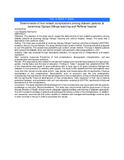| dc.contributor.author | Kavinguha, Lucy Kageha | |
| dc.date.accessioned | 2021-07-15T09:15:01Z | |
| dc.date.available | 2021-07-15T09:15:01Z | |
| dc.date.issued | 2021-11 | |
| dc.identifier.uri | http://www.medicalsciencejournal.com/archives/2020/vol6/issue11/6-11-21 | |
| dc.identifier.uri | http://r-library.mmust.ac.ke/123456789/1787 | |
| dc.description.abstract | Objective: The objective of the study was to assess the determinants of foot related complications among diabetic patients at Jaramogi Oginga Odinga Teaching and referral hospital. Design. The study was a descriptive cross-sectional study.
Setting: The study was conducted at Jaramogi Oginga Odinga Teaching and referral Hospital (JOOTRH), located in Kisumu County Sample. The study utilized simple random method. The study therefore proposed to use 100 patients. The sample was picked through random simple method. The type 2 diabetic patients who came to the diabetic clinic and met the inclusion and exclusion criteria was picked (n = 81).
Analysis: Data was analyzed through descriptive statistics, Chi square test of independence and logistic regression.
Main outcome measures: Prevalence of foot complications, demographic characteristics, self-care characteristics and footcare practices.
Results: The respondents were asked to indicate their background characteristics based on the age group, gender, marital status and the level of education. Findings in Table 1 revealed that, established that 78% of the respondents were aged 41 years and above with a mean age of 43 years indicating that type two diabetes is more prevalent in relatively older people. The study further established that male patients were more than their female counter parts at 64%. Age, gender and marital status did not significantly influence development of foot complications. Respondents’ level of education was the only demographic characteristic that significantly influenced development of foot complications, timing of blood glucose levels did not significantly influence development of foot complications. Daily inspection of feet, use of special protective footwear, and satisfaction with self-care education received at JOOTRH, significantly influenced development of foot complications.
Conclusion: The study established that development of foot complications was associated with the patients’ knowledge on self-care. Recommendations. The study also recommends that the government of Kenya through Ministry of Health should ensure adequate capacity building and training of diabetes specialists. This will increase knowledge of patients and subsequently reduce number of foot complications. In addition, the researcher recommends that further studies on diabetes self-management knowledge could be done in other counties in Kenya in order to generalize the results. | en_US |
| dc.language.iso | en | en_US |
| dc.publisher | International Journal of Medical and Health Research | en_US |
| dc.subject | Determinants , foot, related, complications, among, diabetic, patients teaching and Refferal hospital | en_US |
| dc.title | Determinants of foot related complications among diabetic patients at Jaramongi Oginga Odinga teaching and Refferal hospital | en_US |
| dc.type | Article | en_US |

